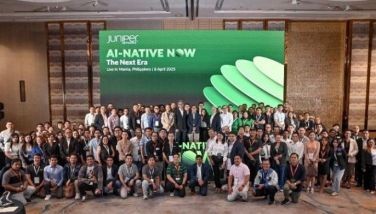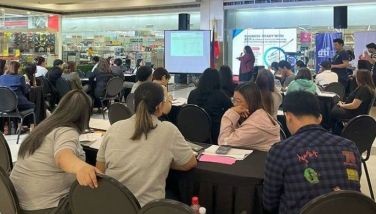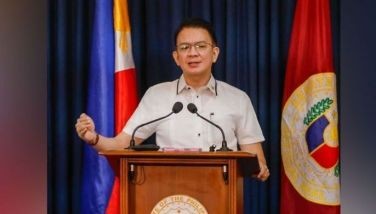India grants landing rights to RP airline

October 11, 2003 | 12:00am
President Arroyo vowed yesterday to tap the estimated 200 million millionaires in India as potential tourists and investors as soon as a designated national flag carrier of the Philippines gets landing rights in several key Indian cities.
Mrs. Arroyo said Indian Prime Minister Atal Bihari Vajpayee gave her this commitment during their talks held at the sidelines of the just concluded ninth Association of Southeast Asian Nations (ASEAN) leaders’ summit.
"The prime minister of India told me he is giving our designated national airline landing rights unilaterally in several key cities in India," she said. "I told him we are in the radar screen of each other."
The President made the announcement in her address before local government executives who attended the Luzon Island Conference of the Union of Local Authorities in the Philippines (ULAP) held in Pasay City the other night.
"India has about 200 million millionaires out of their one billion population. In fact, in your respective towns, you have big Indian communities and many of them still hold Indian citizenship," she said.
The President said the local government officials can offer the Indians in their community "to expand their trade (with) their mother country because they have 200 million millionaires, which is even bigger than the population of the entire Philippines," which stands at 82 million.
Mrs. Arroyo promised Vajpayee that she will "rationalize" the Philippines’ visa rule to enable more Indian tourists to enter the country and businessmen to invest here, particularly in the production of low-cost medicine.
"We buy most of our medicines from India and I hope you are using my administration’s program to procure half-priced medicines from India and being sold in government hospitals," she told the governors and mayors attending the conference.
The President said she was able "to negotiate" new economic benefits for the Philippines in her talks with several heads of state who attended the ASEAN summit in Bali, Indonesia.
"In the end, whatever I negotiate, it will be you — the frontliners — who will translate the gains we make in foreign policy into momentum and effectiveness in our common battle against poverty, against terrorism, against criminality," she said.
Mrs. Arroyo stressed that "as I am the chief executive of our nation, you are the chief executives of your municipalities. Together we share a determination to deliver the best of governance."
Though the Philippines did not suffer as much as its neighboring countries in the region during the Asian financial crisis that started in 1997, the President noted with concern that other countries in the region, including India, are now recovering.
"Our neighbors are starting to accelerate their growth again and this time we cannot afford to be left behind," she said.
Mrs. Arroyo said that she, as an economist, knew that if she did not build domestic demand, "we will suffer, too. How did I build up domestic demand? I built up domestic demand in the provinces, and now you know I released all that internal revenue allotments, even the debts of the previous administrations.
This is why the Philippines still performed better than India and other countries in the region during the past two and a half years despite the global economic slowdown.
A recent forecast by the Asian Development Bank (ADB), however, said the Philippine economy will only grow by four percent this year compared to India, whose economy is expected to grow by six percent.
In terms of per capita growth rate versus gross domestic product (GDP), the Philippines is ranked last in a field composed of China, Hong Kong, Indonesia, Malaysia, Singapore, South Korea, and Thailand.
The international lending institution had forecast that the Philippines will grow by four percent in terms of GDP this year and by 4.5 percent in 2004. GDP is the local output of a country’s economy.
ADB chief economist Ernesto Pernia said whatever gains realized by the Philippines from 1991 to 2001 merely made up for the losses posted from 1981 to 1990.
Most countries in Asia are outpacing the Philippines and are widening the gap, he said, noting that growth has been typically led by consumption as opposed to investment and exports, which are largely the case with its neighbors.
So far, a low investment environment, saved somewhat by strong consumer spending, has plagued the country. Exports remained weak and clearly outpaced by imports.
One area of concern that must be addressed in the immediate future, Pernia said, is the limited investment due to low savings and limited foreign direct investments due mainly to the prevailing poor investment climate.
Other areas that need improvements are: the huge disparity between low deposit earnings rates versus high borrowing rate; postal savings, and a review of the tax structure slapped on savings instruments, he added.
But Pernia said that the country’s GDP is "within fighting range relative to those of its Asian neighbors."
Overall, the Asian region is still considered the fastest growing region in the world at a projected 5.3 percent this year and 6.1 percent next year. The best performing economies are China, Thailand and Vietnam.
Mrs. Arroyo said Indian Prime Minister Atal Bihari Vajpayee gave her this commitment during their talks held at the sidelines of the just concluded ninth Association of Southeast Asian Nations (ASEAN) leaders’ summit.
"The prime minister of India told me he is giving our designated national airline landing rights unilaterally in several key cities in India," she said. "I told him we are in the radar screen of each other."
The President made the announcement in her address before local government executives who attended the Luzon Island Conference of the Union of Local Authorities in the Philippines (ULAP) held in Pasay City the other night.
"India has about 200 million millionaires out of their one billion population. In fact, in your respective towns, you have big Indian communities and many of them still hold Indian citizenship," she said.
The President said the local government officials can offer the Indians in their community "to expand their trade (with) their mother country because they have 200 million millionaires, which is even bigger than the population of the entire Philippines," which stands at 82 million.
Mrs. Arroyo promised Vajpayee that she will "rationalize" the Philippines’ visa rule to enable more Indian tourists to enter the country and businessmen to invest here, particularly in the production of low-cost medicine.
"We buy most of our medicines from India and I hope you are using my administration’s program to procure half-priced medicines from India and being sold in government hospitals," she told the governors and mayors attending the conference.
The President said she was able "to negotiate" new economic benefits for the Philippines in her talks with several heads of state who attended the ASEAN summit in Bali, Indonesia.
"In the end, whatever I negotiate, it will be you — the frontliners — who will translate the gains we make in foreign policy into momentum and effectiveness in our common battle against poverty, against terrorism, against criminality," she said.
Mrs. Arroyo stressed that "as I am the chief executive of our nation, you are the chief executives of your municipalities. Together we share a determination to deliver the best of governance."
Though the Philippines did not suffer as much as its neighboring countries in the region during the Asian financial crisis that started in 1997, the President noted with concern that other countries in the region, including India, are now recovering.
"Our neighbors are starting to accelerate their growth again and this time we cannot afford to be left behind," she said.
Mrs. Arroyo said that she, as an economist, knew that if she did not build domestic demand, "we will suffer, too. How did I build up domestic demand? I built up domestic demand in the provinces, and now you know I released all that internal revenue allotments, even the debts of the previous administrations.
This is why the Philippines still performed better than India and other countries in the region during the past two and a half years despite the global economic slowdown.
A recent forecast by the Asian Development Bank (ADB), however, said the Philippine economy will only grow by four percent this year compared to India, whose economy is expected to grow by six percent.
In terms of per capita growth rate versus gross domestic product (GDP), the Philippines is ranked last in a field composed of China, Hong Kong, Indonesia, Malaysia, Singapore, South Korea, and Thailand.
The international lending institution had forecast that the Philippines will grow by four percent in terms of GDP this year and by 4.5 percent in 2004. GDP is the local output of a country’s economy.
ADB chief economist Ernesto Pernia said whatever gains realized by the Philippines from 1991 to 2001 merely made up for the losses posted from 1981 to 1990.
Most countries in Asia are outpacing the Philippines and are widening the gap, he said, noting that growth has been typically led by consumption as opposed to investment and exports, which are largely the case with its neighbors.
So far, a low investment environment, saved somewhat by strong consumer spending, has plagued the country. Exports remained weak and clearly outpaced by imports.
One area of concern that must be addressed in the immediate future, Pernia said, is the limited investment due to low savings and limited foreign direct investments due mainly to the prevailing poor investment climate.
Other areas that need improvements are: the huge disparity between low deposit earnings rates versus high borrowing rate; postal savings, and a review of the tax structure slapped on savings instruments, he added.
But Pernia said that the country’s GDP is "within fighting range relative to those of its Asian neighbors."
Overall, the Asian region is still considered the fastest growing region in the world at a projected 5.3 percent this year and 6.1 percent next year. The best performing economies are China, Thailand and Vietnam.
BrandSpace Articles
<
>
- Latest
- Trending
Trending
Latest





























